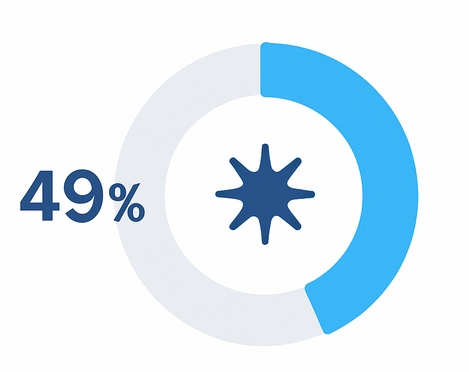AI has redefined how marketing teams build and test ad creatives. Automated systems can generate images, headlines, and variations in seconds, allowing advertisers to run more experiments and adapt to market trends faster than ever.
However, high-speed automation introduces a risk: losing the human nuance that makes a brand trustworthy and relatable. The challenge is no longer choosing between AI or human creativity, but ensuring they work together in a way that strengthens both performance and authenticity.
Why AI Matters in Creative Production
Recent industry reports show that creative quality now accounts for nearly 50 percent of an ad's overall performance potential. At the same time, automated creative tools can reduce production time by up to 70 percent, enabling teams to test and iterate more efficiently.
AI improves creative workflows by:
-
Generating design variations at scale.
-
Tailoring creative formats to specific placements.
-
Analyzing which visual cues drive conversions.
-
Predicting performance outcomes before launching ads.
But while automation accelerates production, it cannot replicate lived experience, culture, or real human insight. This is where balance becomes essential.
The Risk of Over-Automation
When advertisers rely too heavily on AI-generated visuals or language, campaigns can start to feel repetitive, generic, or disconnected from real customer motivations.
A recent study found that 62 percent of consumers prefer ads that feel "human-created," even if AI was involved behind the scenes. Meanwhile, over 70 percent say they disconnect from ads that feel overly automated or impersonal.
Without a human layer of refinement, brands risk blending into a sea of similar-looking content.
How to Keep Ad Creatives Authentic
1. Use AI for Volume, Not Vision
AI is ideal for producing many creative variations quickly, but the core message and emotional direction should always come from human insight.
2. Maintain a Strong Visual Identity
AI models can drift stylistically. Ensure that color palettes, typography, and layout patterns align with your brand’s established identity.
3. Combine Data with Human Interpretation
AI can identify patterns, but humans interpret meaning. Let AI surface winning visual elements, then refine them with human judgment.
4. Prioritize Real Customer Stories
Authenticity grows from real experiences. Use the speed of automation to support storytelling—not replace it.
5. Continuously Audit AI-Generated Assets
Regular review ensures visual coherence, cultural appropriateness, and emotional relevance.
Useful Statistics for Creative Strategy

Creative quality can account for up to 49 percent of overall advertising performance, making it one of the strongest drivers of campaign results
-
Creative quality influences up to 49 percent of advertising sales performance.
-
Automated creative tools can reduce production cycles by 60 to 70 percent.
-
62 percent of consumers trust ads more when they feel human-created.
-
Ads that combine data-driven automation with human insight can see 20 to 30 percent higher engagement.
Additional Reading
Here are three articles from the same publication that complement this topic:
Final Thoughts
AI is not here to replace human creativity—it is here to elevate it. When brands combine automated creative production with real human insight and a clear visual identity, they achieve the best of both worlds: efficient workflows and authentic storytelling.
The future of advertising belongs to teams that know when to rely on automation and when to rely on emotion, intuition, and experience.

